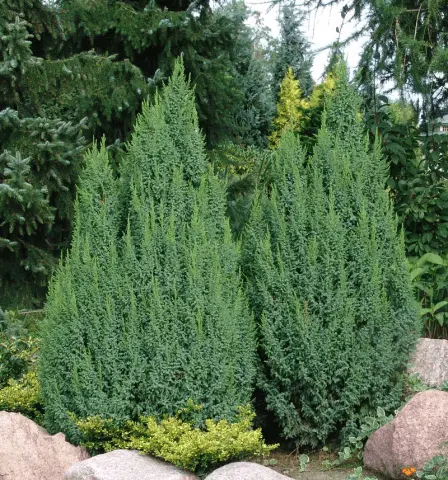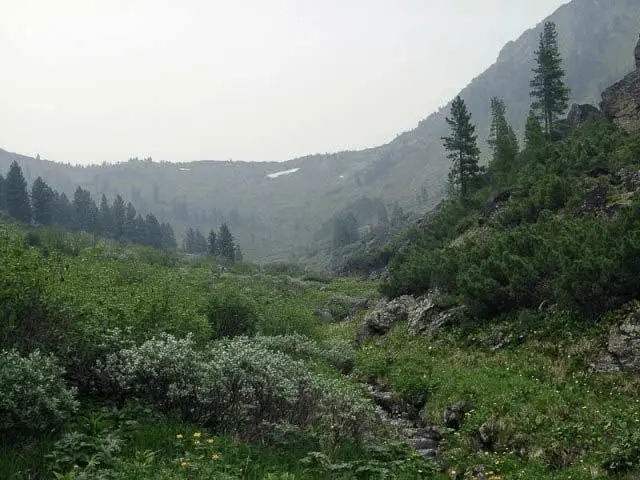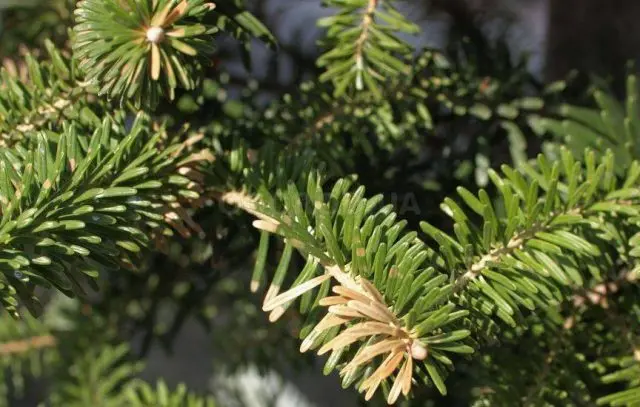Contents
The hard juniper is recognized not only as one of the oldest plant species, but also valuable for landscaping landscapes. In Japan, it is considered a sacred plant, which is planted near temples to ennoble the territory. Exotic beauty, unpretentiousness in care, adaptability to soil and climatic conditions made the species interesting for the transformation of garden and park areas.
Description of juniper hard
Juniper hard belongs to the evergreen coniferous plants of the Cypress family. This is a tall dioecious tree with a dense pyramidal crown, covered with green and light yellow prickly needles. The branches are triangular. Leaves 1,5-3 cm long, pointed and prickly.

Photos and descriptions of hard juniper vary, depending on the growing conditions. Cultivated in domestic and urban conditions, plants have a dense narrow columnar or oval shape. This is especially pronounced in male specimens. Female representatives of the species have a rarer crown. On sandy soils and rocks located along the sea coast, the plant acquires a ground cover appearance with a creeping crown. The use of the vegetative propagation method also makes it possible to grow it in the form of a shrub.

The bark of the trunk is gray-brown, and in old trees it acquires a reddish-brown hue. At 30 years old, the average plant length is 6,5 m, with a trunk diameter of 10 cm. On average, junipers grow no more than 15 m in height and can live up to three hundred years or more.
Distribution of hard juniper (juniperus rigida)
The species is widely distributed within Eurasia. It prefers drier, sandy, lime-rich and well-drained soils. The culture grows singly, less often in groups, on rocky slopes and coasts. The largest population is located near the Serpent Mountain on the Vorskla River and has about a hundred trees.
The plant is also common in Eastern China, in Japan from the island of Kiu Siu to Hondo, in Korea, as well as in the south of Primorsky Krai. Within the latter, hard juniper is found infrequently, mainly in rocky areas, in limestone areas such as Su-chanu, Suzuhe, Daubihe, Maihe. You can also meet him on the coast of the Sea of Japan and in the valleys of the rivers included in it.
Why juniper is hard in the Red Book
On the territory of the country there are about 1 – 2 copies of hard juniper. This is primarily due to the fact that in ten years the plant has only 3-4 seed periods, while the yield outside this time is extremely low. Trees that are weakened and older than 150 years may not grow cones at all between seed years. Difficulty in seed germination leads to weak seed reproduction of the species.
The extraction of limestone, in the zones of deposits of which the highest prevalence of the species is observed, is often accompanied by the death of rare plants. In growing areas, as a result of frequent fires, complete destruction of undergrowth and seedlings is observed. In addition, hard juniper has valuable medicinal properties due to the content of essential oil, and its wood is not subject to decay. As a result, this also has a detrimental effect on the view: it is often cut down. Due to their highly decorative properties, plants are actively dug up for landscaping landscapes.
In 1988, hard juniper was included in the Red Book of Our Country, although it was also included in the extinction risk zone earlier: since 1978, it has already been listed in the Red Book of the USSR. Since 2002, the species has been included in the list of objects protected by the Red Book of the Primorsky Territory.
The plant is grown in 12 botanical gardens of the Federation, it is under protection in the Lazovsky and Ussuriysky reserves.
Ussuri Nature Reserve:

Landing features and care
Juniper hard is unpretentious in care and has high frost resistance. A light-loving plant for planting is recommended to choose a semi-shady place without stagnant moisture.
Like other species of the genus, the culture is unpretentious to the soil and can grow both on sandstones and on rocky soil, but it takes on the most remarkable forms when planted in fertile and medium-fertile lands.
In the care of hard juniper, regular weeding and several top dressings per season are necessary. Watering is not required. For the winter, the branches of the plant need to be bandaged to avoid injury under the weight of snow.
Cultivated hard juniper is propagated by sowing seeds and vegetatively, by cutting and planting young shoots in spring. In nature, seeds from cones are dispersed by the wind.
More information about planting and caring for juniper can be found in the video:
Diseases of hard juniper
If the winter turned out to be warm, the juniper begins to rot, and fungal diseases develop on the branches. To avoid this, the crown should be regularly inspected for damaged branches and cut off so that they do not infect other healthy ones.
Dense stands with abundant moisture are often prone to drying out of branches. Such conditions are favorable for the development of fungi, which is why plants are often exposed to several infections at once.

The main danger for hard juniper, as for all conifers, is schütte, or brown mold. It can begin to develop in the fall, and in the spring a brown coating already appears. The branches gradually begin to turn yellow, and weakened plants may die completely.
Another common fungal disease is trachomycosis. The fungus lives in the soil and first damages the root system and gradually spreads along the trunk and branches. Fungal infections can also become the causative agents of rust and Alternaria. Affected by these diseases, the plants begin to dry out, and the needles in the infected areas turn reddish and brown.

The bark of the plant is also susceptible to disease. Juniper cancer develops as a result of the penetration of fungi into the trunk, where they begin to actively develop, causing cracking and falling of the bark.
Another common disease is nectricosis. With it, red-brown growths grow on the bark, which later darken and dry out. Any disease of the bark also inevitably leads to yellowing and drying of the needles.
Conclusion
Juniper hard can be called one of the best decorative species. The plant does not require special care, but needs protection from fungi. Experts recommend: when using juniper in landscape design, it is necessary to provide it with conditions similar to its natural habitat. Then the plant has the most spectacular appearance, which is successfully used in creating urban landscape compositions, in parks and private areas. The tree looks especially original when forming a bonsai.









